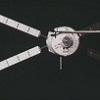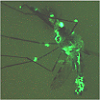How the 21st-century military may make one of our wildest and longest-held dreams come true
“This new millennium sucks! It's exactly the same as the old millennium! You know why? No flying cars!” - Lewis Black
Of all the far-out visions for the future provided us by popular culture (indeed, by this very magazine above almost all else), perhaps none is so conspicuously absent today as the flying car. Other sci-fi fantasies - the invisibility cloak, laser weapons, universal translators, 3-D printers - exist to some degree, if only on a lab bench somewhere. But the flying car, once considered the next logical step in personal transit, simply never took flight.
But now, for the first time since the age of Henry Ford, the flying car has a serious patron. And it’s not some eccentric millionaire or overzealous garage inventor. It’s the United States Department of Defense.
Back in April, DARPA put out a call for proposals seeking a vehicle with some thought-provoking features; a capacity of one to four passengers, enough sturdiness to go off-road, and - most intriguingly - full flight capabilities with vertical takeoff and landing (VTOL). Called Transformer, the program sought “terrain-independent mobility,” not just so soldiers could get around physical obstructions, but also to help them avoid ambushes and that most pervasive threat in America’s current military engagements: IEDs.
In essence, DARPA has asked for a flying Humvee, and they want it by 2015.
For a look back, see our gallery of flying cars throughout history from the pages of PopSci here
Some DARPA initiatives die quiet deaths. Others become NASA or the internet. Transformer lay quiet for a few months, but then the proposals started coming in, complete with futuristic but feasible-looking concept drawings: Humvees fitted with collapsible helicopter rotors or huge ducted fans or folding wings (or a combination of the above) sweeping over rugged terrain or sloping third-world cities, gunners hanging out the side door. You could almost hear Ride of the Valkyries playing over some unseen loudspeaker.
But these designs were different from the fanciful schematics that spring up in garages and on Web sites from time to time. Not in spirit or mechanics necessarily, but in the fact that they sought a concrete prize beyond the satisfaction of flight itself: millions of potential defense dollars to develop the prototypes, and perhaps many millions more in contracts should they succeed.
Last month, Maryland-based AAI Corp. landed a $3.05 million DARPA grant to develop its hybrid wing/rotor Transformer vehicle (above). Then Lockheed Martin scored a similar study contract to develop its own alternative Transformer design (right), employing a huge ducted fan on each wing to provide lift and thrust. Shortly thereafter, jet engine maker Pratt & Whitney Rocketdyne received $1 million to develop a lightweight diesel engine to power the vehicle. The three companies have already put their heads together on the project. With economic incentives and a strategic imperative in mind, it appears the flying car is finally getting off the ground.
There are various explanations as to why the flying car has not already become a reality, but most plainly it seems we ran out of incentive (if not imagination). In the heady days of the 1920s, the flying car was a foregone conclusion: “Today events in the realm of aviation are tumbling along at such a pace that we can almost imagine ourselves spending next summer’s vacation touring the air roads.” These words, typeset in the November 1926 issue of Popular Science, detailed great strides in the machinery of flight that were bringing the technology down to the common man. The piece included a black and white depiction of Henry Ford next to his compact hybrid car-plane, the “Ford Flivver.” According to Ford, his machine would “be brought within the reach of every man’s pocketbook.” He might as well have been talking about the Model T.
But it wasn’t to be. By the time WWII ended, the endless optimism of the 1920s had been thoroughly blunted, first by the Great Depression then by the geopolitical struggles of the 1940s. Upon the post-war return to normality, a different kind of optimism reigned, tempered by rising Cold War anxieties. A military-industrial complex hungry for the best aeronautical engineers also fostered a new view of the sky not as a place to be cruised by the common man, but as an important strategic territory to be dominated by fearsome long-range bombers and rockets destined for space.
Besides, fuel was cheap, asphalt was abundant, and with a massive new interstate highway system connecting all the places people wanted to go, the automobile became king. A series of hybrid car-plane designs - most of them were really just planes with detachable wings - popped up during the ‘40s and ‘50s, but without a clearly defined need for personal flying vehicles the concept was relegated to the purview of science fiction writers and dreamers. By mid-century, personal flying machines went from feasible to fantastical.
But the idea, though pushed to the fringes of invention, never died. Fictional futurism ranging from Judge Dredd to the Jetsons has relied on flying cars to set the scene. The opening sequence to Futurama takes viewers on a first-person drive through the congested “skyways” of a crowded 31st-century metropolis.
Even Back to the Future Part II, the pop culture authority on future predictions, teased us with flying car technology - as well as hoverboards, self-lacing sneakers, and several other predictive technologies that have since come to exist in some form - and that was set in the year 2015. There’s even a Facebook group titled “So it’s 2010, where is my flying car bitch!”
The allure of personal flight isn’t completely lost on regulatory agencies and aviation visionaries either. The FAA’s relatively new Light Sport Aircraft designation allows pilots with relatively few flight training hours to pilot small aircraft under favorable conditions. The LSA designation - intentionally or not - creates a legal space for pilots with minimal training to operate light, non-complex aircraft at low altitudes, as well as a commercial niche for aircraft like the Terrafugia Transition, a four-wheeled folding-wing aircraft that is also drivable on city streets and fits neatly in a home garage.
But the Transition is a “roadable aircraft,” not a flying car. DARPA wants a dual-mode vehicle that requires no runway or special infrastructure considerations. Though not stipulated specifically, ideally the Transformer would automate takeoff and landing so the operating soldier doesn’t also need to be a pilot. Transformer must be efficient, achieving a range of 250 nautical miles on a single tank of fuel. And Transformer has a primary objective: to save soldiers’ lives. That’s not just a noble goal; it creates a high standard for safety as well.
DARPA is willing to open its purse for such a vehicle - up to $54 million over the life of the program - and that’s what makes this attempt at the flying car so exciting. The Transformer Program removes three of the biggest obstacles that have plagued the flying car from its very conception, providing an immediate financial incentive to innovate, clearly defining a need, and seeking technologies that are within reach.
Overcoming the first two obstacles is easy enough for DARPA: the Pentagon provides the funding, and the need to protect troops from IEDs is lost on no one who follows the news out of Iraq and Afghanistan. But technology will be the real differentiator between Ford’s Flying Flivver - which never saw production after a fatal crash during test flights - and the flying cars of the future.
In the crowded skyways of the future, safety would clearly be the paramount concern - no one would want the same number of cars on the road today zooming haphazardly through the skies above metropolitan areas. But automated on-board systems can simplify takeoff and landing for operators, and larger networked air traffic control systems could conceivably automate flight itself, moving vehicles around crowded urban skies while keeping them on safe trajectories. We’re already hard at work on cars that safely navigate themselves - DARPA is a pioneer in this field, and Google recently revealed it has a fleet of self-driving cars - so it’s not a huge leap to networked vehicles that navigate the skies in similar fashion. And should the weather turn bad, cities could ground traffic - we are talking about flying cars here after all.
The progress of the Transformer program points optimistically toward an increasingly aerial future for the common driver, as defense technology tends to roll downhill. If DARPA succeeds in providing the military with a flight-capable automobile, it’s difficult to imagine a scenario where that technology isn’t commercialized at some point. It certainly won’t happen overnight (or in the next decade for that matter), but with the technology sitting right in front of us we would be foolish to keep our rubber restricted to the road.
Besides, we called it back in 1926: “How soon we shall fly our own machines depends, experts agree, on how quickly foolproof machines can capture public confidence. Once that confidence has been gained and public demand created, quantity production and lower prices will be possible. The wonderful history of the automobile will be repeated in the air.”





